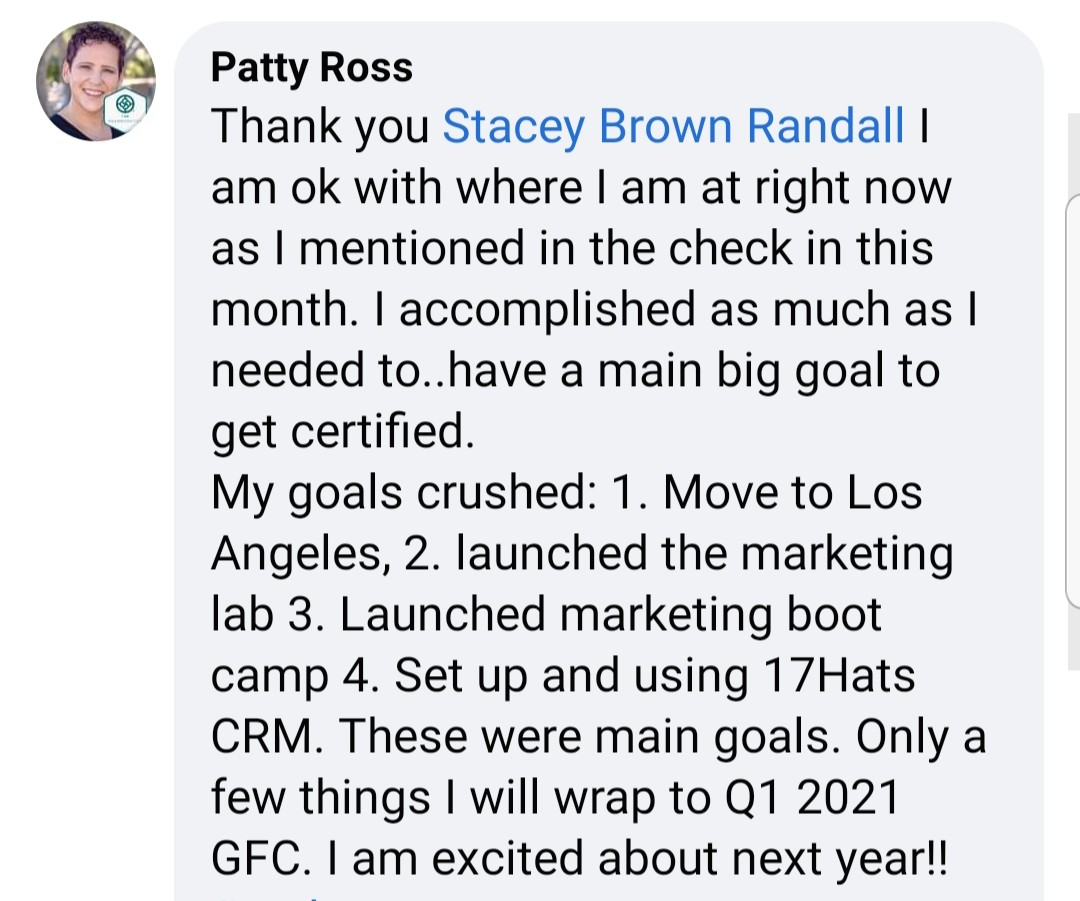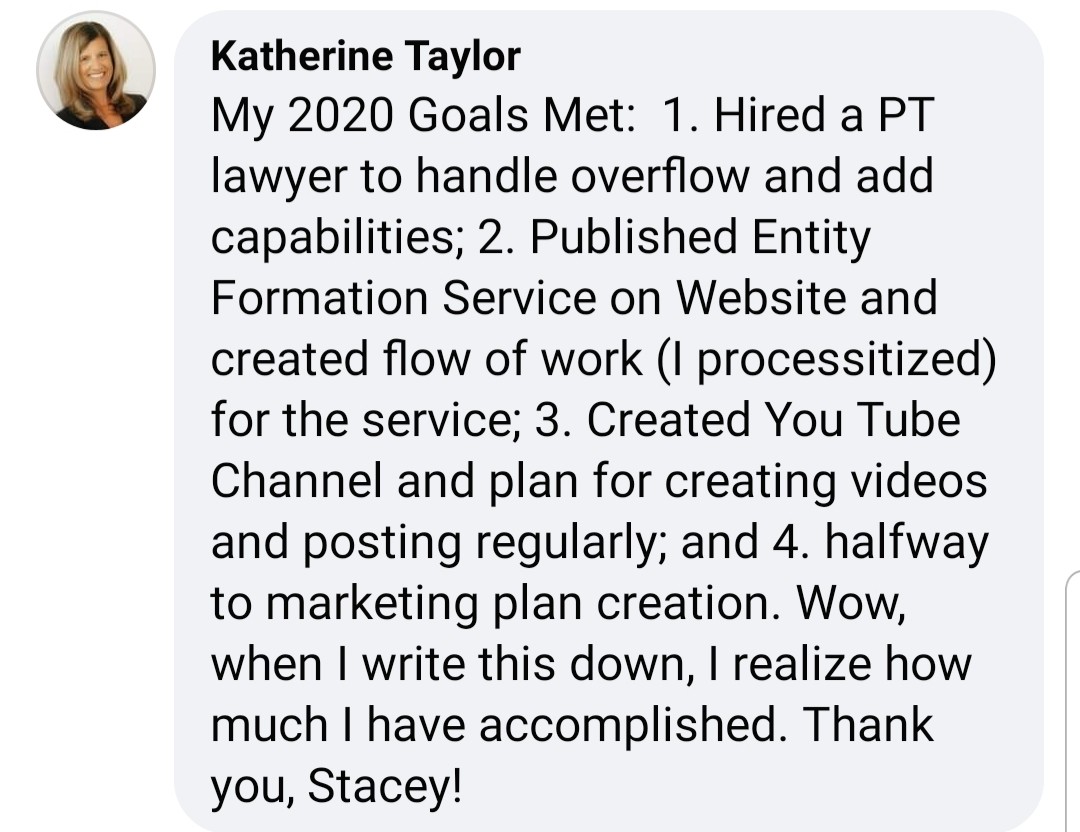Let’s play a little word association. When I say a word and you say the first thing that comes to mind. Ready? Here we go.
Goals.
More than likely you had one of two reactions.
Annoyance. Or pure joy.
If you associate “setting goals” with annoyance and rolling your eyes, I'm convinced it's because you've been doing it all wrong.
Yep.
And I’ll prove it to you.
If you don't love the idea of getting your goals locked and loaded and then CRUSHING them throughout the year… it’s time we change that.
So, if you hate the idea of goals, please don't stop reading. Give me a chance to change your mind.
But let’s get real for a minute… whether you love setting goals or not… setting goals is the easy part. Execution of those goals is where it gets hard, but it’s also where it gets good. Because when we see our goals come to fruition – when they happen… amazing, amazing things happen.
The secret to loving “goals” is all in how you set them, so let me teach you how to set them up for success.
SECTION 1: Welcome to the Reverse Goal Setting™ Process
SECTION 2: Reflection (Step 1)
SECTION 3: The 5 - 3- 1 (Step 2)
SECTION 4: Finishing Strategy (Step 3)
SECTION 5: Crushing the Beginning of the Year
SECTION 1: Welcome to the Reverse Goal Setting™ Process
I really want you to push yourself or stretch yourself to be willing and open to looking at goals differently this year. To do that, I’m going to walk you through the Reverse Goal Setting™ process step-by-step. But as good as this article will be, downloading the workbook will help make this process so much easier and smoother. So please grab the Reverse Goal Setting™ workbook now.
If you have questions as you read this article or complete the workbook and want answers from me, then please join me in our temporary Reverse Goal Setting pop up group. The Reverse Goal Setting™ pop up group is a group dedicated just for this process and is only available from mid-November through January to help you set goals like never before. So hop in to get your answers, find community and be supported.
The History of the Reverse Goal Setting™ Process:
I know I look at goal setting differently from how most teach it. There are a lot of different frameworks out there and I actually think many of them are pretty short-sighted.
What I teach is how to reframe your goals so you give them a fighting chance to become a reality.
When I first started working as a business and productivity coach, I realized that I had a knack of breaking down a concept to its simplest form so when I taught it, it would be easily grasped. I was able to do that by reverse engineering the process, which I started applying to every process or concept or idea I taught. So when I was helping other small business owners on their goals, I naturally reversed the process so we arrived at goals that actually mattered. And after years of doing this at an annual business retreat I held for business owners, I saw the process click for those owners and started calling the process the Reverse Goal Setting™ process.
Now, it’s your turn to experience this life changing experience. Don’t believe me? Here’s what other business owners shared about their experience with the process.
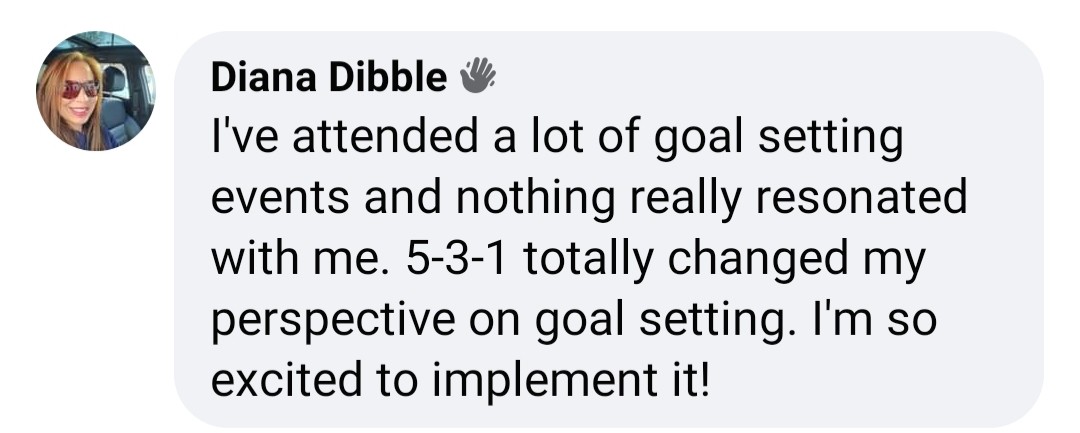
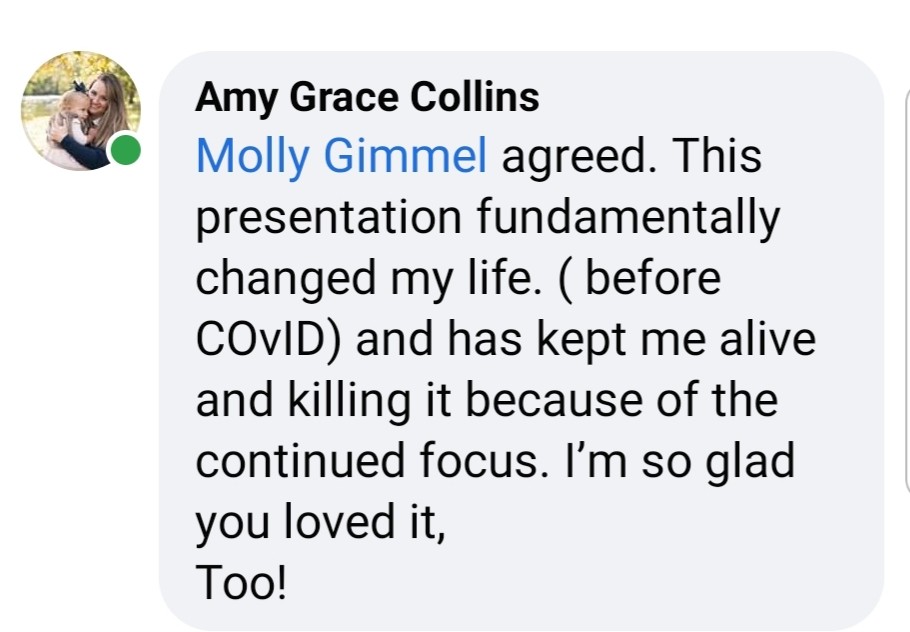
Ok, your turn. Let’s dive in.
The Reverse Goal Setting™ process can be broken down into 3 steps. Reflection, 5-3-1 and the Finishing Strategy. Throughout this article, I’ll break down the 3 steps for you in detail.
But keep in mind – if you just read this article without taking the action I’m recommending – you won’t be setting your goals, you’ll just be reading about setting goals.
SECTION 2: Reflection (Step One)
While this step may not seem that important to “getting your goals set,” it’s actually very important. You need to take a moment and allow yourself to reflect back on the current year. I find it’s important to reflect back on how my business performed and how well I did with finishing my goals.
2 Ways to Reflect (and both are necessary)
When considering how my business did for the year, I look at specific metrics and then benchmark them against those same metrics in years past. You should create your own metrics to see how you did and to compare to previous years as well. These metrics and answering a few key questions helps you do a complete business year end review.
Business Year End Review
Here are some examples of the data or metrics to consider.
- Revenue – overall and by line item (revenue stream)
- Expense
- Profit
- # of Repeat Clients/Projects
- # of New Clients/Projects
- Causes of Significant Growth or Decline
- Sales Strategies Performance (prospecting, marketing, referral)
Then compare your results of this year to the business numbers you had at the end of last year. How did 2020 compare to 2019? Best way to do this is using the chart below or use page 1 in the workbook.
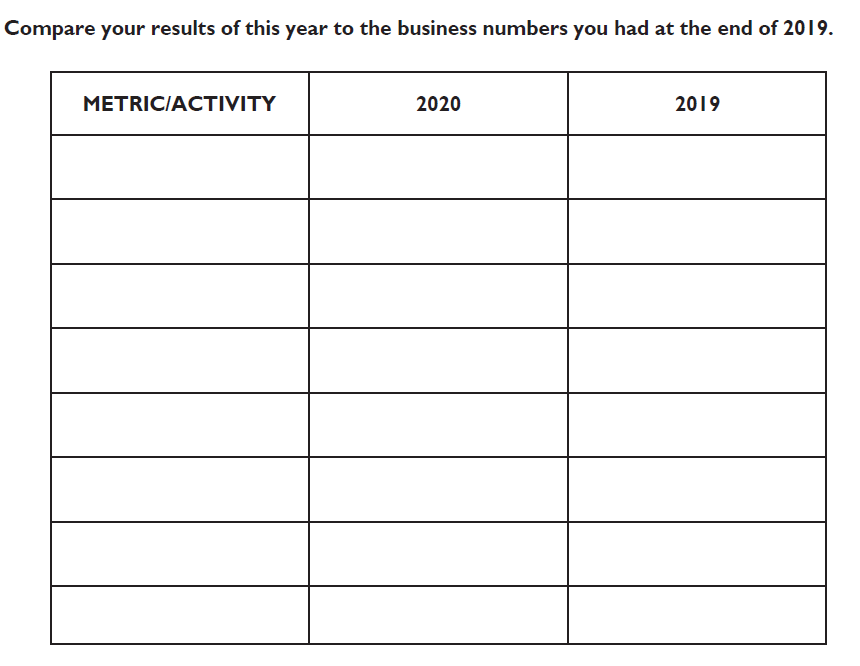
And then ask yourself - what is working in your business and what is not working. Allow that to help you understand what areas need your focus for next year.
Goals Year End Review
Next up is looking back at how well you completed your goals for the year. This step is pretty simple as you need to write down the goals you did complete versus the goals you didn’t complete. In the workbook, this is on page 2.
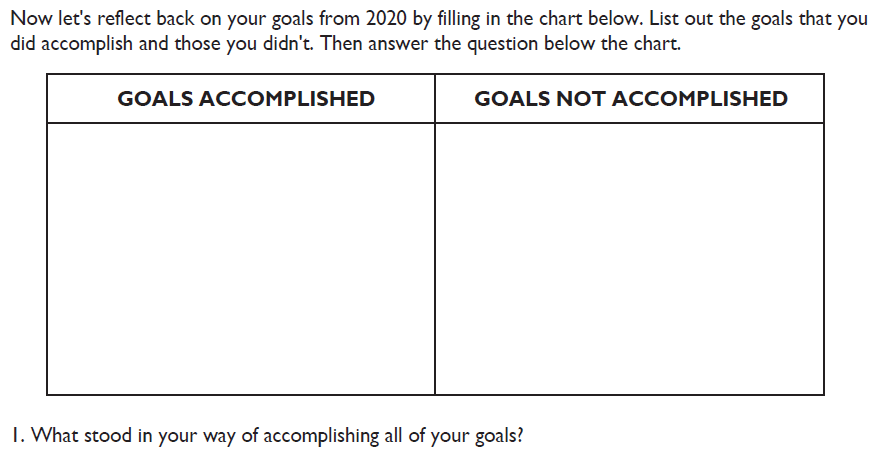
Wheel of Life
I love the idea of checking in to see how you’re feeling and doing at the end of the year so you can be intentional of what you set for the next year. This Wheel of Life concept comes from a previous business coach of mine, Lorin Beller. For those of you following along in the workbook, this is on page 4. Here’s how it works.
First you rate yourself on a scale of 1 to 10 in nine specific areas of life. The scale is 1 meaning poor and 10 meaning amazing.
Then once you rate yourself in the 9 areas, you plot your results on the wheel and connect the dots to make some kind of “circle-like” shape.
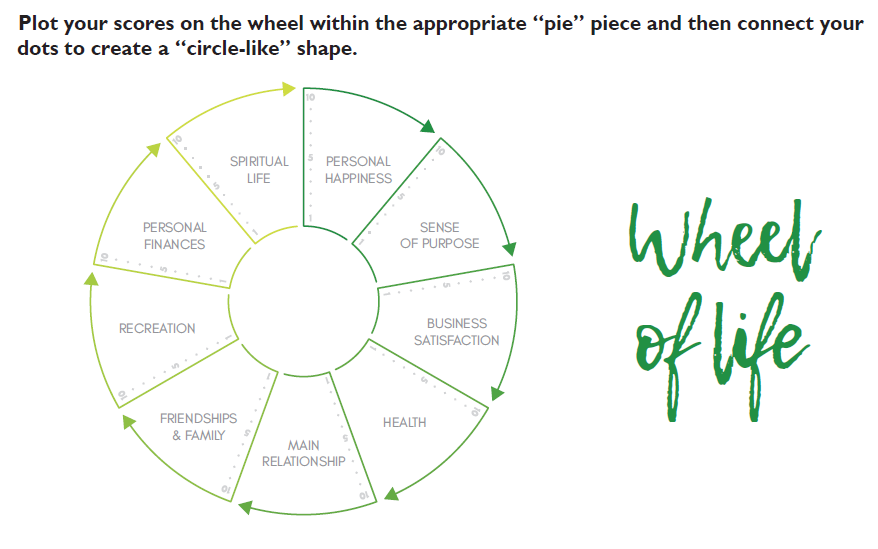
Now once you have your shape, I love to ask this question… “If that shape were the shape of the 4 tires of your car, how smooth would your ride be?”
Let that sink in for a minute and take stock of what really matters and what you want to be intentional on improving.
SECTION 3: The 5 - 3 - 1 (Step Two)
The basic concept behind the Reverse Goal Setting™ process is the reversing part. Meaning we back into our goals for next year, we don’t just select the goals with no frame of reference for next year. So to be able to back into our goals for the next year, we need to start by looking further out and then reversing. We start by going 5 years into the future and thinking about what we want to have accomplished.
The 5 Year Vision
Before you can start thinking about your world in 5 years, you need to get personal with who you’ll be in 5 years. And the quickest and easiest way to do that is to write down how old you’ll be in 5 years. I know it seems simple. (And for me it’s the most uncomfortable part of the 5 Year Vision.) But the recognition of your age at the end of five years from now helps connect better with what you need to be doing for the “you in 5 years.”
If you’re following along in the workbook, you write down not only your age at the end of five year but also the ages of those most significant in your life like your spouse/partner, children, etc. That really helps crystalize what you need to be focused on when we realize we are all getting older.
Now that your age is written down, close your eyes for a moment and think. Think about what you want to accomplish at the end of 5 years. What do you want your world to look like? These are business and personal desires. Some examples include:
- Open second location of your business or new office
- Hit $1M or $100K revenue mark
- Owner’s pay of $100,000
- Pay off mortgage
- Take a trip of a lifetime
- Be debt free
- Pay off school loans
- Buy a second home/vacation home
- Write your first book
- Reduce your time needed in the business to 50%, etc.
There isn’t a right or wrong accomplishment. These are what you want for your life and only what you want matters (as long as it jives with the other significant people in your life).
As you think through what you want to accomplish in 5 years, it’s time to start putting these down on paper. If you’re not using the workbook (page 4 if you are), right down the bullet points (called Vision Points) in a column on the left.
Next, directly across from each vision point, write down your why. Ask yourself, “Why do I want to accomplish this?” Then write the why down in the right column opposite from the accomplishment.
The final step of the 5 Year Vision is to read your why aloud and ask yourself “Do I really want that?” If yes, keep it. If no, make changes.
Because remember, anything you say you want to accomplish in 5 years is going to take work, effort, time, and resources. So you better be committed to what it’ll take to get there.
And please remember, this isn’t a contest. This is what you want for your life and if ANYTHING on the list makes you groan, please reconsider why it is on your list.
The 3 Year Milestones
Once you have your 5 Year Vision in place, you’ll move to the 3 Year Milestones. Just like with the 5 Year Vision, you’re going to start by writing down your age at the end of three years from now and the ages you wrote down for the others in your life. If you’re following along in the workbook, this step is on page 5.
Then for each accomplishment you wrote down that you want in 5 years (you’re vision points)… you need to figure out where you need to be in 3 years to know you are on track to making the vision point a reality. The question to ask yourself is, “What are the milestones I need to hit by the end of three years to be on pace?”
So for example: If you said “increase the size of your team to 6 people in 5 years” …will all 6 people be hired in the 5th year or will you stair-stack adding new team members? Would you need to have brought on 3 or 4 people by the end of 3 years so you are on pace to have 6 hired at the end of 5 years.
Keep in mind the “half-way mark” or 3-year milestone isn’t always half of your goal…you might see yourself ramp up quickly in the next two years or move a little slower until you confirm additional streams of revenue to help you pay for the increase in staff. Just consider where you need to be at the end of 3 years to be on track to hit your 5 Year Vision.
Again, we aren’t participating in the comparison society. Take it off if it doesn’t excite you. Don’t add anything if it doesn’t light you up. I don’t mean you won’t have work to do on your list - I just mean that you better be committed to doing the work if you want the reward.
The 1 Year Plan
So now you have mapped out your 5 Year Vision which includes individual vision points. And you’ve established the 3 Year corresponding milestones for each vision point. Our next step is to reverse one more time.
Following the same process for the 3-year milestones, ask yourself where do you need to be at the end of next year (one year) to be on track to hit the 3-year milestones. Because remember, if we’re on pace at the end of 3 years, then we are on pace to make our 5 Year Vision a reality. This step is where we create our overall picture of next year, where we get clear on individual goals for one year.
Using the same example from before: If you said “increase the size of your team to 6 people in 5 years, and be at 3 hires at the end of year 3…then where do you need to be at the end of next year to be on pace? Would you need to have potentially hired your first full-time person and mapped out the second position you will hire for in year 2? Consider what you need to accomplish in one year to be on pace. But remember, you do have year 2 and year 3 to hit your 3 Year Milestones so don’t overwhelm yourself in this first year.
If you’re using the workbook I provide, then you will have completed - at this point - pages 4, 5 and 6. And now you’re ready to move on to the final step of the Reverse Goal Setting™ process, the Finishing Strategy.
SECTION 4: The Finishing Strategy (Step Three)
The Finishing Strategy consists of 3 smaller steps and its purpose is to set ourselves up for success. Setting goals is the easy part, finishing them is hard. So we need to fully commit to going through the entire Reverse Goal Setting™ process is we want to give our goals a fighting chance next year. Here are the 3 steps within the Finishing Strategy.
- Setting Your Intention Word for 2021
- Creating Individual Roadmaps for Each Goal
- Getting Real with Yourself
Setting Your Intention Word for 2021
If you’ve ever set an Intention Word, then this step will feel very familiar. This step asks you to pick a word for the new year of how you want or need to show up, a word that stirs you, gets your attention, re-focuses you. It’s a word that can help remind you how to show up every day of next year.
There isn’t a right or wrong word but I do ask that you try to limit it to just one word, or a hyphenated word. What you don’t want are multiple words.
Here’s an image from some of the students in the Goal Finishers Club with the words they each selected from a previous year.
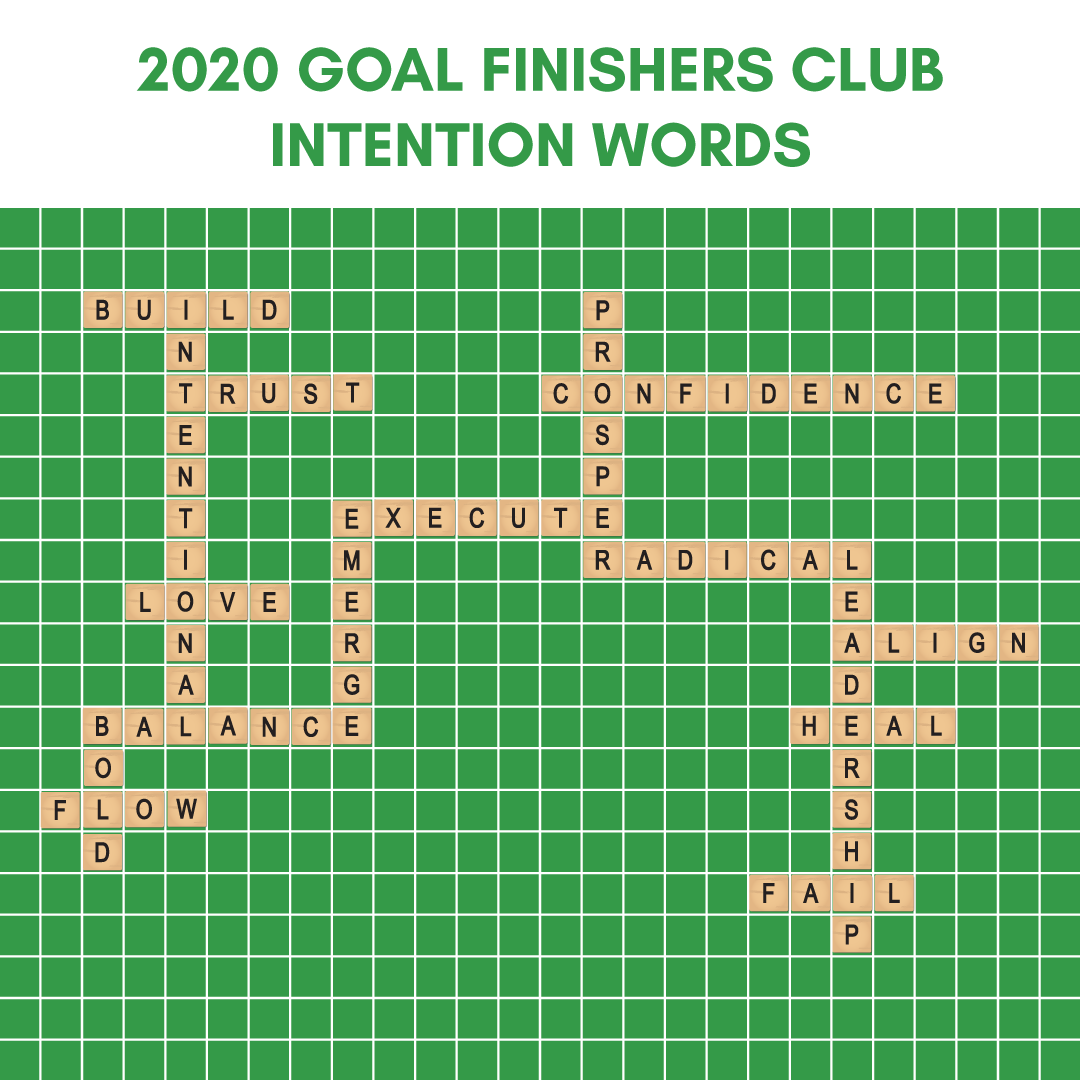
Once you have your Intention Word you need to decide where you will put the word as a daily reminder. I suggest you pick a place where you’ll see the word daily - on your desk, often-used password, wallpaper image on your phone or computer.
Creating Individual Roadmaps for Each Goal
If you haven’t been using the workbook up to this point, it will be important to make sure you have copies of page 9 available. Page 9 is the Individual Goal Worksheet. Each goal that you have as part of your 1 Year Plan needs its own worksheet, so if you have 4 goals you need 4 copies of the worksheet.
For each goal, you’ll complete a worksheet by answering the following:
Goal Name: be crazy specific with the goal and have fun with naming it too! It's not "make more revenue"... it's "Hit $500,000 in revenue so I'm on my way to growing a bada$$ business I love!"
Pick the Goal Type: every goal fits into one of three categories. Goals are either Project-Based, Activity-Based and Habit-Based.
- Project-Based Goals are goals that have a start date and an end date with steps in between, dues dates for each step and a consideration to who should help you plus budget. Examples of project goals are writing a book, launching a new service line or product, starting a new YouTube channel, etc.
- Activity-Based Goals are typically number related where you need to track outcome throughout the year. If you set a revenue number in your business, then you need to track your revenue month-over-month to know if you are on pace to hit the revenue goal. But you may also track the number of new clients, number of referrals received, or amount added to business savings every month.
- Habit-Based Goals are typically personal in nature and they are daily habits you are trying to instill in your life. They need daily tracking (sometimes weekly). Examples include daily devotional or meditation, working out, drinking celery juice (yes, that’s a real example).
Write Down the Goal's Why: This comes from the 5 year vision point this goal rolls up to and the why behind it. You’ll want to make sure you’re clear on the why behind this 1-Year Goal.
Completion Date: You cannot put down March 31, 2021 or December 31, 2021 as the deadline to complete each goal. You need to space them out throughout the year and focus on quarterly completion.
Final step for each goals worksheet is to map out how you'll complete the goal based on its category in the blank space provided on the worksheet. For project-based goals, you’ll map out steps. For activity-based goals, you’ll map out the metrics to track. And for habit-based goals, you’ll consider how you’ll track the daily action.
While this step can feel overwhelming, it’s not if you get clear on what’s important and what’s not. This part of the process will force you to focus on what really needs to be done and what you need to bless and release.
Getting Real with Yourself
One of the main reasons we don’t accomplish our goals is because we don’t know how best to motivate ourselves or hold ourselves accountable as the year drags on. And at some point for all of us the year will start to drag on and then fly by. If you want to accomplish your goals you have to continually make space for them. You have your personal life to do (family, kids, paying bills, yard work, etc.) and you have your business to run, work to do (taking care of clients, sending out invoices, paying bills, updating your website). And somewhere between those two big facets of your life, is you making space to work on your goals. So getting real with yourself is critical.
I encourage you to consider taking a free assessment called the Four Tendencies Quiz. It’s 11 questions that will help you assess how you are best motivated which is an important ingredient when setting and accomplishing goals. I’m not associated with the assessment but I believe it is a great tool in understanding yourself. (I'm an Obliger, by the way.)
In addition, it’s important you get real with how you need to show up in the new year. Some questions to ask yourself are…
- If you were to accomplish all of your goals next year that you have on your One Year Plan, how would you feel?
- What do you need to do differently (attitude, behavior, actions) to have the new year look different?
- How will you make those changes in your life?
SECTION 5: Crushing the Beginning of the Year
At this point, you’ve finished the Reverse Goal Setting™ Process. I hope you feel amazing and encouraged that you have a roadmap like no other to crush next year. At this point, we have one step left.
The final step is to put your accountability mechanism in place for 2021. If we want to be successful in crushing our goals, we need to hold ourselves accountable to finishing them.
Accountability Mechanism
Setting goals is really the easy part, finishing them is the hard part. It takes commitment and the ability to make them a priority in March, July and September as the busyness of our business and life takes over. We have to make time to finish them, throughout the year, all year long. So our accountability mechanism is built to help us be successful. Here are the points to consider for your Accountability Mechanism.
1. Goals in writing (which should be done if you created your worksheets)
2. Then transfer those written goals in a dashboard of some sort where you update monthly and track your progress. The key here is to update your progress in the dashboard every single month.
3. Have accountability built-in through a business buddy, mastermind or joining the Goal Finishers Club (of course!). You need a human who cares about your success!
4. Celebrate your wins, big or small. This creates momentum when momentum is hard to come by in the busyness of life.
5. Find a supportive community. A rising tide really does lift all boats so surround yourself with people who believe you can accomplish your goals and are working to accomplish theirs. (Like the community inside the Goal Finishers Club!)
It is with these 5 points above that I built the Goal Finishers Club. The Goal Finishers Club continues to have incredible success over the years helping its members CRUSH their goals.
If you set goals every year but don't consistently accomplish them... then this Club is where you need to be! I mean where else can you find super cool accountability, a smashing dashboard, and lots of gold stars? The Goal Finishers Club!
So here is what the Club is all about...
- 2021 Goals Dashboard to track your progress, and I check it too - every month!
- Monthly live accountability (replay available)
- Monthly support, prompts and specific focus strategies (know how to deal with the "muck in the middle"? I'll teach you!)
- Earn gold stars
- Celebrate wins
- Early Bird Discount if you sign up before January 1, 2021!
I encourage you to check out the Goal Finishers Club… it’s the final piece of your goal crushing puzzle. You have reflected back on the year, reversed your goals in a new way with a powerful connection to your future, and set a roadmap for your individual goals. Now you just need the right accountability mechanism to get you through all 365 days next year.
Join the Goal Finishers Club for 2021 and let’s see you finish, crush, and shine.
We’ll do it together! Just like I did with these business owners who were members of the 2020 Goal Finishers Club.
